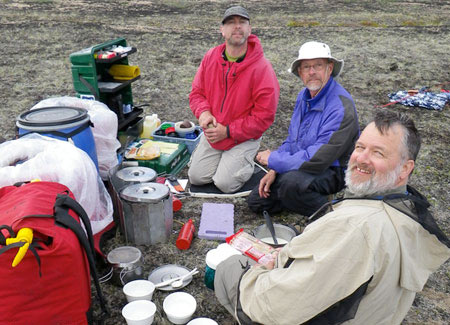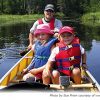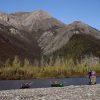Far North Kitchen Gear

A far north kitchen. Photos courtesy Brian Johnston.
Kitchen gear depends on the menu and food. I usually start the day with cold granola, hot oatmeal, cooked Red River cereal, or pancakes with hot drinks. Lunch is no cook GORP, bannock, crackers, cheese, PB and jam. An appetizer, salad, soup, or dessert complement a bean, pasta, potato, or rice main course for supper. Consider your cooking and menu style and adjust the following items as required.
Stoves and Related Equipment
I use single burner stoves—Brunton or MSR—and always bring a backup and a repair kit. Some Far North routes will have drift wood for fires, and some will not, so research your rivers ahead of time. In addition to the stoves, I bring:
- Fuel—1/8 L per person per day. In the north, I purchase fuel in 1-gallon (3.78 L) metal cans
- Windscreens for the stoves
- Lighter or welder sparker—safe, easy to use, and reliable. For everyday needs, a cheap lighter or matches may be suitable, but I use a welder sparker “shoot-a-lite” because I can work it with cold and wet hands
- Twig and wood stoves—many feature a small fan that blows air into the combustion area
- Pruning shears or clippers—useful for gathering small branches if using a twig stove or burning garbage
- Stove repair and maintenance kit—it’s a long trip, even longer without a working stove
Pots and Pans
Pots and lids—a nesting set with small, medium, large.
Kettle or French press—for tea and coffee.
Non-stick frying pan
Pot lifter and leather gloves—for hot pots and lids as well as draining pasta.
Baking
Use whatever baking system works for you on southern canoe trips, just remember that it may be colder and windier in the far north so baking may require more time and shelter (wind protection).
I have used all these baking systems with success:
- Heavy-duty frying pan and lid
- Lightweight frying pan with a lid
- Two lightweight frying pans, one flipped over as a lid
- Outback oven, lid, temperature gauge, and hood—a product made for baking on a single burning camp stove
Food Preparation
Rehydration jar—500 ml and 1,000 ml Nalgene Jars. Jars are easier to empty and clean than bottles, and I use them daily to rehydrate dried food.
Cooking Utensils—sharp knife, whisk, flipper, spoon, cheese grater, spatula, wooden spoon, etc.
Dip Cup—a small measuring cup works well for measuring ingredients, serving soup or hot water.
Spice kit—including spice for fish.
Thermos—filled in the morning and used at lunch.
Utensils and Plates
Consider a natural material such as wood or bamboo for personal utensils as it feels nice.
Cup—insulated or not, lid or not.
Plate and/or bowl—I insulate my bowl with bubble wrap or blue sleeping pad foam. A bowl can be multipurpose and used for berry picking or storing leftover food. I also like a plastic container with a snap-on lid.
KFS—knife, fork, spoon, or spork.
Water and Washing
Water filter or purification—I do not filter water daily but I pack something in case we end up camping in an area without an acceptable water source.
Water container—collapsible or foldable. For when my kitchen site is a long walk from a water source.
Foaming soap bottle or hand sanitizer—a group or kitchen item that encourages hand washing.
Wash kit—basin, soap, scrubber, cloth. I use a folding sink.
Next: Navigation and Safety Gear
 Brian Johnston, Editor of the Paddle Canada Canoe Program. Brian has paddled Far North rivers of all kinds: swift descents from the mountains into the Mackenzie Valley, subarctic rivers emptying into the Arctic Ocean, traverses from the Northwest Territories to Nunavut, and drainages into Hudson Bay.
Brian Johnston, Editor of the Paddle Canada Canoe Program. Brian has paddled Far North rivers of all kinds: swift descents from the mountains into the Mackenzie Valley, subarctic rivers emptying into the Arctic Ocean, traverses from the Northwest Territories to Nunavut, and drainages into Hudson Bay.









